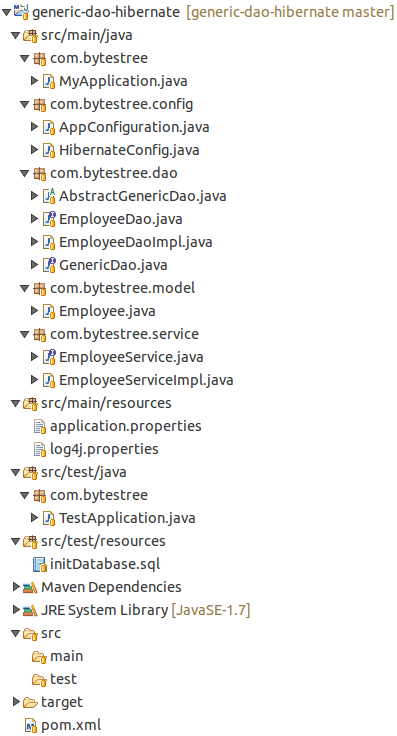This article shows an example of implementation of Generic DAO in Hibernate for common CRUD operations. Generic DAO is used for not to repeat CRUD operation methods for each Entity DAO class.
Features
The example application will have following features. The complete source code is available at the end of this article.
- A standalone Java application for performing database operations.
- All database operations are performed using Hibernate
- Transaction Manager configuration
- A Generic DAO class for common DAO/CRUD operations
- Specific DAO operations should be in respective Entity DAO class
Technology Stack
- Spring Framework – 4.2.5.RELEASE
- Hibernate – 4.3.11.Final
- Database – PostgreSQL – 9.4
- JDK – 7
Dependencies and project structure
pom.xml
Project Structure:

Generic DAO Hibernate project structure
Database
We are using PostgreSQL database for this example. We have an Employee table which holds basic employee details like firstname, lastname, designation, and salary. We will add some employees after creating table as test data for our application. The script for table creation and test data insert is as follows:
Spring and Hibernate Configuration
We are using XML free configuration so every configuration will be in Java files. The basic spring context configuration to load spring context and add ‘component scan’ will be in AppConfiguration.java We will keep all hibernate related configurations in a separate file called HibernateConfig.java. This file configures beans for DataSource, SessionFactory and Transaction Manager(HibernateTransactionManager). The database URL and other configurable things are mentioned in application.properties file in classpath and loaded using @PropertySource annotation.
Generic DAO Interface and Implementation
Now we are creating an interface for generic dao called GenericDao.java. This interface will include all common DAO and CRUD operation methods required for each entity dao class. We should be having methods like Save, SaveOrUpdate, Delete, Find, Delete and Find All, findByExample, clear, flush, etc. You may add any additional methods if required.
Once the interface is defined we will be adding an abstract class AbstractGenericDao.java. This class will implement all the methods defined in GenericDao.java. We are keeping this as abstract as this shouldn’t be used directly by any service methods. All Entity Dao classes should extend it to use implementation provided by this class. As we are using Hibernate we need to inject the SessionFactory in AbstractGenericDao.java to implement all DAO methods. See the interface and implementation shown below:
Model, Service and DAO Layer
Now let’s add some services which will call some DAO methods. We will be using generic methods as well as a custom method written specifically for particular DAO. For our example, we have service methods to get all employees, save new employee if not exists and a custom method to get maximum salary given to any employee. To get all employees and save a new employee we will use methods defined in generic dao, which are findAll(), findAllByExample() and save(). To get the maximum salary we will be writing a custom method in EmployeeDao.java which is a DAO class belongs to Employee table.
EmployeeDao.java interface should extend to GenericDao.java interface to get all common methods. EmployeeDaoImpl.java should extend to AbstractGenericDao.java to access implementation of all generic methods. Thing to note here is if you have any other table then, that table’s DAO class can also get all generic methods by extending its interface and implementation class to GenericDao.java and AbstractGenericDao.java, which is the main purpose of having GenericDao.
Application class
Here is the application class MyApplication.java which will call services from the service layer. It will first get all employees, add a new one if it does not exist and then get all employees again. All these operations will use generic dao methods. After this, it will search for maximum salary given to any employee by calling a DAO method written specifically for Employee DAO.
Client Application
Finally, let’s check the client application. TestApplication.java which will load the spring context and call a method in MyApplication.java.
To test and run the application just run the TestApplication.java as Java application.
Source Code
The complete source code (maven project) is available at GitHub (keep java compilation level to 1.7).
